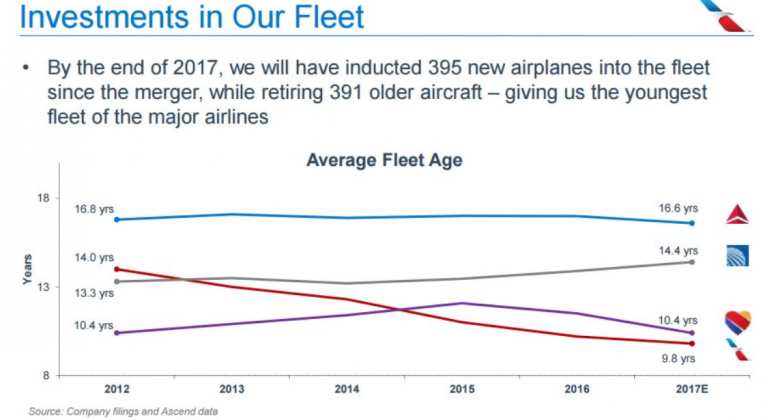In theory, I would choose to fly in a newer plane over an older one. It’s the obvious choice. By extension, it would seem to follow that I’d favor an airline with the younger aircraft fleet over the airline with older planes. For the same reason.
In reality, I’ve never bothered to check and compare the average fleet ages of airlines and factored that data into my booking decisions. Price, convenience, frequent-flyer miles: Those items influence my choice of airline. Average aircraft age? Not so much.
Whether through hypocrisy or laziness, I just can’t be bothered to run a check on contending airlines’ fleet age every time I book a flight. One U.S. airline is hoping that I, and you, will pay more attention.
In its presentation at today’s J.P. Morgan Aviation Conference, American Airlines singled out its fleet’s age as a particular point of pride. Among the Big 4 airlines, American has had the youngest fleet since mid-2014, and will continue to enjoy that advantage at least through 2017.
Related:
American has significantly out-invested Delta and United in its aircraft modernization program, spending more than $5 billion in each of the past three years, and plans to spend another $5.5 billion in 2017. As a result, the average age of American’s planes will be 9.8 years in 2017, versus 10.4 years for Southwest, 14.4 for United, and 16.6 for Delta.
Younger planes are a win-win, for the airline and for its customers. For American, a newer fleet should mean greater fuel efficiency and reliability, both of which ultimately translate into higher profits. And for travelers, the newer technology means more comfort and convenience.
So if I were considering airlines’ aircraft age, and American were on my list of prospective carriers for a particular trip, American would get the nod, all things being equal. If I weren’t a lazy hypocrite.
Reader Reality Check
Does average aircraft age factor into your decision-making when booking flights?
After 20 years working in the travel industry, and almost that long writing about it, Tim Winship knows a thing or two about travel. Follow him on Twitter @twinship.
This article first appeared on SmarterTravel.com, where Tim is Editor-at-Large.




I do consider fleet age when choosing airlines, especially for long-haul flights and here is why:
Comfort – I’ll take a brand new B787/A350 over a B767 any day. Not only do you get more comfortable pressure, bigger windows and better lighting., you also have a better shot at nice seats, big overhead bins and clean toilets. When airlines install their newest business class seats, they don’t necessarily replace the toilets, bins or economy seats and carpets – so you get a more comfortable flight on new planes on average.
Safety/Operations – all other things equal, a younger fleet is going to have fewer incidents than an older fleet, which impacts reliable operations as well as safety. Allegiant has a very old fleet (21.8y!) and the highest number of incidents. Even with good maintenance, there will be incidents – like the stress discovered from high numbers of departures/landings, etc.
I generally pick airlines with younger fleets (like LH, ANA, SQ, ANZ,…) over UA or DL and I do pick newer plane types of older ones, when I have a choice…